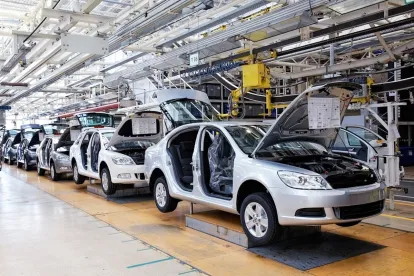The latest phase of digitization in manufacturing or “smart manufacturing” has transformed the automotive industry. Through the growing use of artificial intelligence (AI), machine learning, and automation, auto manufacturers are now more than ever able to overcome operational difficulties and solve maintenance issues before they occur. Here are some of the key aspects and technologies auto manufacturers are using:
-
Digital twins: A digital twin, also known as a surrogate model, is a virtual representation used to reflect a real-world product. This digital counterpart simulates the real product’s performance.1 An automobile’s digital twin is made up of the entire automobile: its software, mechanics, and behavior.2 The use of a digital twin allows automotive manufacturers to replicate the production process and identify potential complications or failures. Examples include:
-
Product testing. A digital twin allows automotive manufacturers to experiment with different designs to optimize product performance. A digital twin of a car tire allows manufacturers to virtually simulate the tire performance in different weather conditions.3
-
Predictive maintenance. Predictive maintenance forecasts when automotive components will break down and to fix them preemptively. Digital twins allow automotive companies to identify potential issues and schedule maintenance before the problem occurs.
-
Performance monitoring. Digital twins constantly collect and analyze data on the vehicles they replicate. Tesla, for example, creates a digital twin of all its vehicles. These virtual replicas are used to determine whether a car is working as intended. Tesla uses this information to update vehicle performance.4
North America accounted for around 38% of the digital twin market in 2021.5 The global digital twin market size is projected to reach US $155.83 billion by 2030, with a Compound Annual Growth Rate (CAGR) of 37.5% in the next seven years.6 The automotive and transport sector is expected to account for the fastest growth rate percentage as developments in electric vehicles drive the adoption of digital twin technology.7
-
-
Internet of Things: Automotive Internet of Things (IoT) is a system of devices that exchange data through an internet connection. This allows automotive devices to share information with other vehicles connected to the internet. Vehicles manufactured with IoT collect performance data and share it with the cloud. Manufacturers can then process this data and assess potential risks and necessary steps for moving forward. IoT allows manufacturers to communicate maintenance system updates to consumers so manufacturers may address issues before a car breaks down.
-
AI in supply chain: AI has made the transition from raw material to the manufacturing of the vehicle to customer delivery significantly easier. For years, one of the biggest challenges in the automotive industry has been the risk of a single, small mistake affecting the entire manufacturing process. A problem with one supplier tier, for example, can stop the entire vehicle manufacturing process.8 AI-powered supply chains can adapt and respond to any unforeseen issues in the manufacturing process. AI-based approaches have the potential to reduce forecasting errors by 30 to 50 percent.9 “Smart factories” are becoming increasingly prevalent, as manufacturers are replacing the error risk of manual labor with self-improving systems. Several renowned automotive manufacturing companies are working towards fully automated AI systems that can make supply-chain management decisions autonomously.10
-
Machine learning: The use of machine learning and AI systems are powerful tools for precision manufacturing in the automotive industry. Machine learning systems assist manufacturers in detecting anomalies and improving designs. In the automotive industry, an appealing design can increase sales by over 30%.11 Machine learning can predict the popular aesthetic appeal and generate alluring and innovative designs.
-
AI customer experiences: Automotive manufacturers have recently been relying on artificial intelligence to improve customer experiences. AI can provide customers with virtual sales assistants. AI learns from past purchases and customer interactions to provide tailored insight to each customer based on their needs. The increased adoption of AI among manufacturing companies allows companies to use data from prior interactions to predict market forecasts.12
As the automotive industry continues to expand, manufacturers should be aware of the increasing use of AI, machine learning, and automation leaders in the automotive industry are using. “Smart” manufacturing is prevalent throughout the manufacturing lifecycle, from supply chain to customer services. Manufacturers looking to remain competitive should remain up to date on the rapidly progressing uses of digitization and AI in the sector.
Special thanks to Massa Almufti, a summer associate in Foley's Dallas office, for her contributions to this article.
FOOTNOTES
1 NAM, 9 key considerations for Digital Twins in manufacturing, for-digital-twins-in manufacturing-15841/?stream=business-operations (last visited Jul 17, 2023).
2Siemens, From vehicle design to multi-physical simulations, (last visited Jul 16, 2023).
3 Sven Dharmani, How digital twins give manufacturers a real-world advantage , (Feb. 24, 2020).
4 Jess Coors-Blankenship, Taking Digital Twins for a Test Drive with Tesla, Apple , (April 29, 2020)
5 Straits Research, Digital Twin Market Size is projected to reach USD 185.78 Billion by 2031, growing at a CAGR of 38.8%: Straits Research, https://www.globenewswire.com/en/news-release/2023/01/30/2597777/0/en/Digital-Twin-Market-Size-is-projected-to-reach-USD-185-78-Billion-by-2031-growing-at-a-CAGR-of-38-8-Straits-Research.html, (Jan. 30, 2023).
6 Bloomberg, Digital Twin Market to be Worth $155.83 Billion by 2030: Grand View Research, Inc., (Feb. 15, 2023).
7 Id.
8 Jorge Amar, AI-driven operations forecasting in data-light environments, ( last visited Jul 16, 2023).
9 Matthew Breunig, Building smarter cars with smarter factories: How AI will change the auto business, (last visited Jul 16, 2023).
10 Id.
11 Burnap, Alex and Hauser, John R. and Timoshenko, Artem, Product Aesthetic Design: A Machine Learning Augmentation (November 1, 2022). MIT Sloan Research Paper No. 5814-19, Available at SSRN: https://ssrn.com/abstract=4253967 or http://dx.doi.org/10.2139/ssrn.4253967
12 Danny Asnani, 4 Customer Experience Solutions Reshaping Manufacturing , (Mar. 6, 2023).




 />i
/>i
